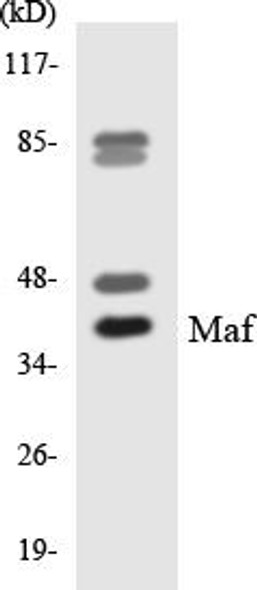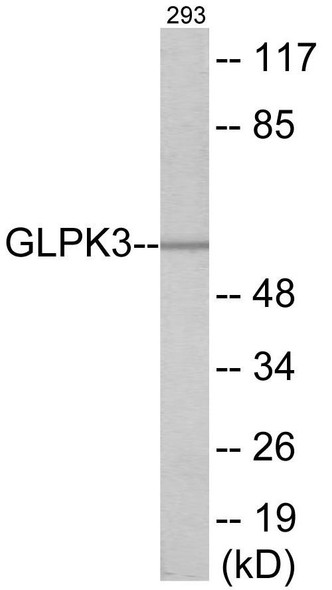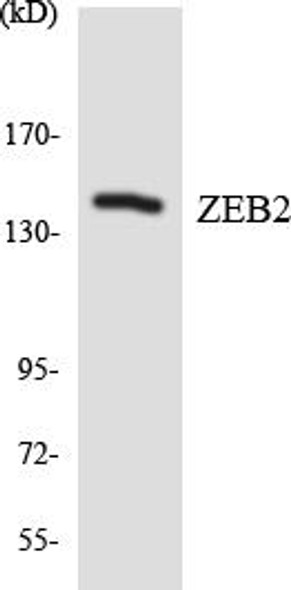MAPK3 Colorimetric Cell-Based ELISA
- SKU:
- CBCAB01119
- Product Type:
- ELISA Kit
- ELISA Type:
- Cell Based
- Reactivity:
- Human
- Mouse
- Rat
- Detection Method:
- Colorimetric
Description
MAPK3 Colorimetric Cell-Based ELISA
The MAPK3 Colorimetric Cell-Based ELISA Kit is specifically designed for the accurate and sensitive detection of MAPK3 levels in cell lysates and tissue homogenates. This kit offers high specificity and reproducibility, providing reliable results for a variety of research applications.MAPK3, also known as ERK1, is a key signaling protein in the MAPK/ERK pathway, regulating various cellular processes such as cell growth, differentiation, and survival.
Dysregulation of MAPK3 has been linked to various diseases, including cancer, inflammatory disorders, and neurodegenerative diseases, making it a valuable target for therapeutic development and biomarker research.With its easy-to-use format and rapid results, the MAPK3 Colorimetric Cell-Based ELISA Kit is an essential tool for researchers studying MAPK3 signaling pathways and its role in disease progression.
| Product Name: | MAPK3 Colorimetric Cell-Based ELISA |
| Product Code: | CBCAB01119 |
| ELISA Type: | Cell-Based |
| Target: | MAPK3 |
| Reactivity: | Human, Mouse, Rat |
| Dynamic Range: | > 5000 Cells |
| Detection Method: | Colorimetric 450 nmStorage/Stability:4°C/6 Months |
| Format: | 96-Well Microplate |
The MAPK3 Colorimetric Cell-Based ELISA Kit is a convenient, lysate-free, high throughput and sensitive assay kit that can detect MAPK3 protein expression profile in cells. The kit can be used for measuring the relative amounts of MAPK3 in cultured cells as well as screening for the effects that various treatments, inhibitors (ie siRNA or chemicals), or activators have on MAPK3.
Qualitative determination of MAPK3 concentration is achieved by an indirect ELISA format. In essence, MAPK3 is captured by MAPK3-specific primary antibodies while the HRP-conjugated secondary antibodies bind the Fc region of the primary antibody. Through this binding, the HRP enzyme conjugated to the secondary antibody can catalyze a colorimetric reaction upon substrate addition. Due to the qualitative nature of the Cell-Based ELISA, multiple normalization methods are needed:
| 1. | A monoclonal antibody specific for human GAPDH is included to serve as an internal positive control in normalizing the target absorbance values. |
| 2. | Following the colorimetric measurement of HRP activity via substrate addition, the Crystal Violet whole-cell staining method may be used to determine cell density. After staining, the results can be analysed by normalizing the absorbance values to cell amounts, by which the plating difference can be adjusted. |
| Database Information: | Gene ID: 7867, UniProt ID: Q16644, OMIM: 602130, Unigene: Hs.234521 |
| Gene Symbol: | MAPK3 |
| Sub Type: | None |
| UniProt Protein Function: | MAPKAPK3: a member of the MAPKAPK family of protein kinases. Activated by growth inducers and stress stimulation of cells. In vitro studies demonstrated that ERK, p38 MAP kinase and Jun N-terminal kinase were all able to phosphorylate and activate this kinase, which suggested the role of this kinase as an integrative element of signaling in both mitogen and stress responses. This kinase was reported to interact with, phosphorylate and repress the activity of E47, which is a basic helix-loop-helix transcription factor known to be involved in the regulation of tissue-specific gene expression and cell differentiation. |
| UniProt Protein Details: | Protein type:Protein kinase, CAMK; Protein kinase, Ser/Thr (non-receptor); Kinase, protein; EC 2.7.11.1; CAMK group; MAPKAPK family; MAPKAPK subfamily Chromosomal Location of Human Ortholog: 3p21.3 Cellular Component: cytoplasm; cytosol; nucleoplasm; nucleus Molecular Function:ATP binding; calcium-dependent protein serine/threonine kinase activity; calmodulin binding; calmodulin-dependent protein kinase activity; MAP kinase kinase activity; protein binding; protein serine/threonine kinase activity; signal transducer activity Biological Process: activation of MAPK activity; cell surface receptor linked signal transduction; innate immune response; MyD88-dependent toll-like receptor signaling pathway; MyD88-independent toll-like receptor signaling pathway; nerve growth factor receptor signaling pathway; peptidyl-serine phosphorylation; protein amino acid autophosphorylation; Ras protein signal transduction; response to cytokine stimulus; response to lipopolysaccharide; response to stress; signal transduction; stress-activated MAPK cascade; toll-like receptor 10 signaling pathway; toll-like receptor 2 signaling pathway; toll-like receptor 3 signaling pathway; toll-like receptor 4 signaling pathway; toll-like receptor 5 signaling pathway; toll-like receptor 9 signaling pathway; toll-like receptor signaling pathway; vascular endothelial growth factor receptor signaling pathway |
| NCBI Summary: | This gene encodes a member of the Ser/Thr protein kinase family. This kinase functions as a mitogen-activated protein kinase (MAP kinase)- activated protein kinase. MAP kinases are also known as extracellular signal-regulated kinases (ERKs), act as an integration point for multiple biochemical signals. This kinase was shown to be activated by growth inducers and stress stimulation of cells. In vitro studies demonstrated that ERK, p38 MAP kinase and Jun N-terminal kinase were all able to phosphorylate and activate this kinase, which suggested the role of this kinase as an integrative element of signaling in both mitogen and stress responses. This kinase was reported to interact with, phosphorylate and repress the activity of E47, which is a basic helix-loop-helix transcription factor known to be involved in the regulation of tissue-specific gene expression and cell differentiation. Alternate splicing results in multiple transcript variants that encode the same protein. [provided by RefSeq, Sep 2011] |
| UniProt Code: | Q16644 |
| NCBI GenInfo Identifier: | 74762148 |
| NCBI Gene ID: | 7867 |
| NCBI Accession: | Q16644.1 |
| UniProt Secondary Accession: | Q16644,B5BU67, |
| UniProt Related Accession: | Q16644 |
| Molecular Weight: | |
| NCBI Full Name: | MAP kinase-activated protein kinase 3 |
| NCBI Synonym Full Names: | mitogen-activated protein kinase-activated protein kinase 3 |
| NCBI Official Symbol: | MAPKAPK3 |
| NCBI Official Synonym Symbols: | 3PK; MK-3; MAPKAP3; MAPKAP-K3; MAPKAPK-3 |
| NCBI Protein Information: | MAP kinase-activated protein kinase 3 |
| UniProt Protein Name: | MAP kinase-activated protein kinase 3 |
| UniProt Synonym Protein Names: | Chromosome 3p kinase; 3pK |
| Protein Family: | MAP kinase-activated protein kinase |
| UniProt Gene Name: | MAPKAPK3 |
| UniProt Entry Name: | MAPK3_HUMAN |
| Component | Quantity |
| 96-Well Cell Culture Clear-Bottom Microplate | 2 plates |
| 10X TBS | 24 mL |
| Quenching Buffer | 24 mL |
| Blocking Buffer | 50 mL |
| 15X Wash Buffer | 50 mL |
| Primary Antibody Diluent | 12 mL |
| 100x Anti-Phospho Target Antibody | 60 µL |
| 100x Anti-Target Antibody | 60 µL |
| Anti-GAPDH Antibody | 60 µL |
| HRP-Conjugated Anti-Rabbit IgG Antibody | 12 mL |
| HRP-Conjugated Anti-Mouse IgG Antibody | 12 mL |
| SDS Solution | 12 mL |
| Stop Solution | 24 mL |
| Ready-to-Use Substrate | 12 mL |
| Crystal Violet Solution | 12 mL |
| Adhesive Plate Seals | 2 seals |
The following materials and/or equipment are NOT provided in this kit but are necessary to successfully conduct the experiment:
- Microplate reader able to measure absorbance at 450 nm and/or 595 nm for Crystal Violet Cell Staining (Optional)
- Micropipettes with capability of measuring volumes ranging from 1 µL to 1 ml
- 37% formaldehyde (Sigma Cat# F-8775) or formaldehyde from other sources
- Squirt bottle, manifold dispenser, multichannel pipette reservoir or automated microplate washer
- Graph paper or computer software capable of generating or displaying logarithmic functions
- Absorbent papers or vacuum aspirator
- Test tubes or microfuge tubes capable of storing ≥1 ml
- Poly-L-Lysine (Sigma Cat# P4832 for suspension cells)
- Orbital shaker (optional)
- Deionized or sterile water
*Note: Protocols are specific to each batch/lot. For the correct instructions please follow the protocol included in your kit.
| Step | Procedure |
| 1. | Seed 200 µL of 20,000 adherent cells in culture medium in each well of a 96-well plate. The plates included in the kit are sterile and treated for cell culture. For suspension cells and loosely attached cells, coat the plates with 100 µL of 10 µg/ml Poly-L-Lysine (not included) to each well of a 96-well plate for 30 minutes at 37°C prior to adding cells. |
| 2. | Incubate the cells for overnight at 37°C, 5% CO2. |
| 3. | Treat the cells as desired. |
| 4. | Remove the cell culture medium and rinse with 200 µL of 1x TBS, twice. |
| 5. | Fix the cells by incubating with 100 µL of Fixing Solution for 20 minutes at room temperature. The 4% formaldehyde is used for adherent cells and 8% formaldehyde is used for suspension cells and loosely attached cells. |
| 6. | Remove the Fixing Solution and wash the plate 3 times with 200 µL 1x Wash Buffer for five minutes each time with gentle shaking on the orbital shaker. The plate can be stored at 4°C for a week. |
| 7. | Add 100 µL of Quenching Buffer and incubate for 20 minutes at room temperature. |
| 8. | Wash the plate 3 times with 1x Wash Buffer for 5 minutes each time. |
| 9. | Add 200 µL of Blocking Buffer and incubate for 1 hour at room temperature. |
| 10. | Wash 3 times with 200 µL of 1x Wash Buffer for 5 minutes each time. |
| 11. | Add 50 µL of 1x primary antibodies (Anti-MAPK3 Antibody and/or Anti-GAPDH Antibody) to the corresponding wells, cover with Parafilm and incubate for 16 hours (overnight) at 4°C. If the target expression is known to be high, incubate for 2 hours at room temperature. |
| 12. | Wash 3 times with 200 µL of 1x Wash Buffer for 5 minutes each time. |
| 13. | Add 50 µL of 1x secondary antibodies (HRP-Conjugated AntiRabbit IgG Antibody or HRP-Conjugated Anti-Mouse IgG Antibody) to corresponding wells and incubate for 1.5 hours at room temperature. |
| 14. | Wash 3 times with 200 µL of 1x Wash Buffer for 5 minutes each time. |
| 15. | Add 50 µL of Ready-to-Use Substrate to each well and incubate for 30 minutes at room temperature in the dark. |
| 16. | Add 50 µL of Stop Solution to each well and read OD at 450 nm immediately using the microplate reader. |
(Additional Crystal Violet staining may be performed if desired – details of this may be found in the kit technical manual.)










